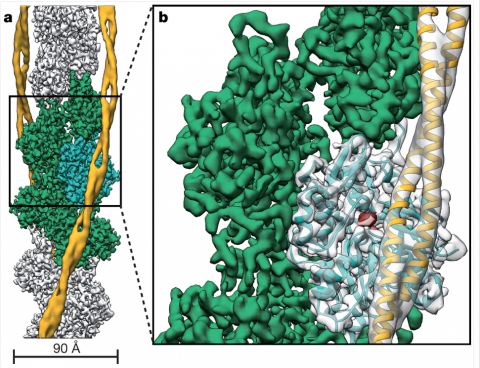
While "go big" is the motto for many science initiatives, Penn State researchers are hoping a cutting-edge microscope will allow them to "go deep" to promote biomedical research and discoveries in materials science.
The purchase of a cryo-electron microscope, recently approved by the Penn State Board of Trustees, freezes samples at cryogenic temperatures -- which usually start at or below -297 degree Fahrenheit -- to cut down on radioactive interference and improve resolution to the atomic level. Penn State's cryo-electron microscope will allow researchers to see down to 3 Angstroms, almost at the resolution of a single carbon atom, according toJim Marden, professor of biology and director of operations, Huck Institutes of the Life Sciences.
Marden added that the device will likely find immediate use in research conducted by Penn State scientists on enzymes, viruses and the structure of the nucleosome. Solving these structures will lead to other discoveries and new disease treatments, since drug and vaccine design require knowledge about how molecules interact at the scale of individual atoms. But, its potential to lead to other discoveries and treatments is considerable.
"Now we have a novel freezing technique, image sensor and algorithms that allow us to see these detailed structures and thus understand function," said Marden. "We are on the edge of revealing how life works and we know that this involves imaging -- and being able to see detail."
The cryo-electron microscope is a specialized piece of research equipment that costs $8.6 million. Marden expects the Materials Characterization Labin the Materials Research Institute to also benefit from the cryo-electron microscope.
"The materials scientists will use this scope to better understand soft materials and this new microscope will allow new types of collaborations at the interface of the fields of materials science and life sciences," said Marden. "For example, targeted delivery of drugs using nanoparticles will benefit greatly from visualizing the engineered particles and how they interact with cell surfaces.
The microscope will also serve as a critical tool in reaffirming Penn State's role as a leader in promoting the convergence of the life sciences and materials science, according to Peter Hudson, the Willaman Professor of Biology and director of the Huck Institutes of Life Sciences.
"We are at a most exciting time in the life sciences -- the technological developments with the Cryo EM will allow us to interpret function from structure and in so doing revolutionize biomedical, food, disease and materials research," said Hudson. "Universities are at an auspicious junction and the leading universities like Penn State need to invest in this technology to be able to be in the leading pack of researchers and entrepreneurs."
